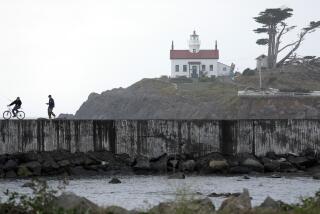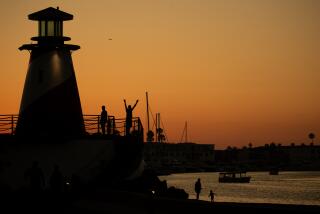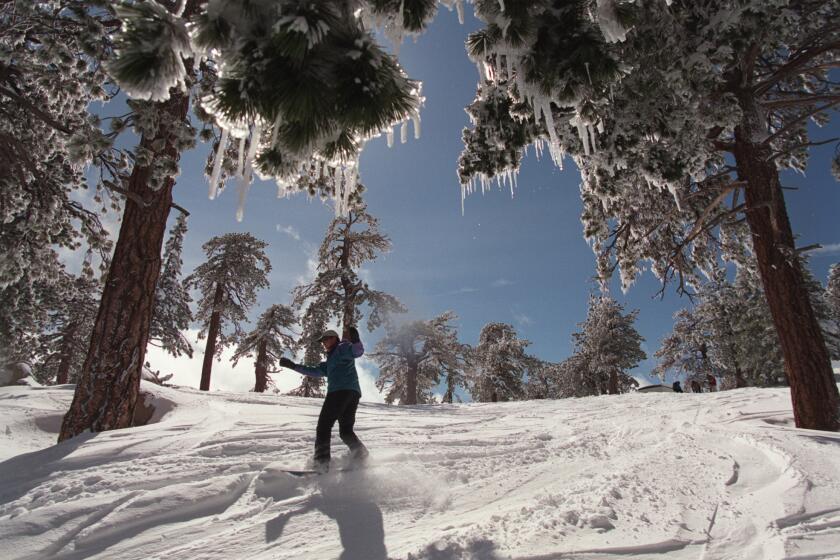Cooler weather, higher humidity aid battle against Northern California wildfire
Cooler temperatures and higher humidity are expected to help firefighters battling the 60,000-acre Rocky fire in Northern California, but the weather shift could bring thunderstorms and a risk of new fires to parts of the parched Sierra Nevada.
Temperatures have dropped into the 60s and 70s, winds have calmed and humidity has increased throughout Northern California because of an approaching storm, said meteorologist Brooke Bingaman of the National Weather Service in Sacramento.
The change was positive news for firefighters battling the Rocky fire in near-record heat and will allow them to make progress on the massive blaze.
“The plus that Mother Nature has been giving is that we do have moisture in the area,” she said.
But with the weather shift also comes the possibility of thunderstorms.
A slight chance of thunderstorms is expected Tuesday and Friday over the Sierra and coastal mountain ranges. The incoming storm, however, may change as the week progresses. The summer storm is expected to sit over Northern California, so there is a chance that thunderstorm activity could increase Friday.
“We are keeping our eye on it,” Bingaman said.
More than 13,000 residents were affected by voluntary or mandatory evacuation orders as the Rocky fire spread across three counties. It was 12% contained Monday morning but was threatening 6,301 structures in Colusa, Lake and Yolo counties. Flames have consumed 50 structures, including 24 homes.
Fueled by erratic winds and bone-dry woodlands, the fire has destroyed 24 residences and 26 outbuildings, according to the California Department of Forestry and Fire Protection. More than 2,900 firefighters were on the scene, but flames were difficult to reach because of steep, rugged conditions with limited access, Cal Fire said.
The Rocky fire is burning east of Clear Lake in a remote area roughly between California 29 and California 16, according to Cal Fire, and is the biggest of numerous fires burning in drought-plagued Northern California.
“Dry thunderstorms” -- lightning and wind with very little rain -- are the main cause of roughly two dozen large blazes that have led to one firefighter’s death and prompted Gov. Jerry Brown to declare a state of emergency.
Two state highways were closed, the 20 and the 16, which were serving as fire breaks where crews started backfires. Evacuation centers were set up at two schools. Law enforcement agencies have gone door-to-door and sent evacuation requests and orders over the radio, television and social media.
Nearly three dozen evacuees spent Sunday night at a Red Cross shelter at Middletown High School, and some lingered Monday morning.
Vicki Estrella sat in the driver’s seat of her SUV working on a crossword puzzle while waiting to hear from her husband. He had left to see if he could get back to their house in Spring Valley to check on their llamas, chickens and cats, which they had to leave behind when they evacuated on Sunday night.
They have lived there for 22 years and have evacuated from fires before. This one, however, was particularly fearsome.
“It’s just been so dry,” she said. “We have a fire every so often. But this one has been moving so fast.”
The smell of smoke was thick when they evacuated and she could see flames in the distance, but she’s fairly confident their home is far enough away from the worst of the fire.
She’s mostly worried about the llamas -- the oldest one, Cuzco, likes to knock over the water trough so he can roll in the mud. By now, she thought, her husband would need to refill the water.
“There are pretty widespread evacuations,” said Brad Alexander, chief spokesman for the governor’s emergency services office. “The big issue is this is an area that hasn’t had burning in several decades.
“They’ve got chaparral that is over 6 feet tall,” Alexander said. “When you have vegetation that big and dense in an area like that, it is going to cause flames to race up and down canyon walls and hillsides.
“It can move as fast as the wind can carry it,” faster sometimes than a person can run, Alexander said. “So when you have perfect conditions for an explosive fire, it is critical folks are listening.”
More than 9,000 firefighters have been battling fires across California after thousands of lightning strikes sparked several hundred small wildfires.
“We’ve had lightning throughout the state,” said Lynne Tomachoff, a spokeswoman for Cal Fire, “but Southern California has seen a little bit more precipitation, which helps.”
Fire Capt. David Ruhl, 38, went missing Thursday during the initial attack on the Frog fire.
Ruhl, a U.S. Forest Service firefighter from South Dakota, was driving alone, scouting ways to attack a fire burning in Modoc County, just south of the Oregon border. He became trapped and died after erratic winds whipped the blaze and it suddenly expanded, a Forest Service spokesman said. His body was found the next day.
The married father of two “left his home state to help protect one of California’s majestic forests,” Brown said. “We extend our deepest condolences to his family.”
Megerian reported from Middletown and Rocha from Los Angeles.
For California news, follow @ChrisMegerian and @VeronicaRochaLA on Twitter.
ALSO:
Firefighters battle 200-acre wildfire north of Ojai
Special Olympics athlete from Albania found in Northern California
After 2 at rave die of apparent overdoses, supervisors demand probe
More to Read
Start your day right
Sign up for Essential California for news, features and recommendations from the L.A. Times and beyond in your inbox six days a week.
You may occasionally receive promotional content from the Los Angeles Times.







